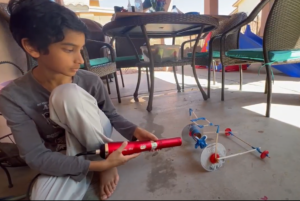Can Tech Help Reset Our Expectations?: Packback, Inquiry-Based Learning and the Power of AI
Key Points
-
Students are often taught to academic goals that are too low–baselines rather than aspirational ceilings.
-
In the wake of COVID-19, today’s classrooms students are surviving, not excelling – but technology can democratize access to information and help teachers promote creative and critical thinking in their classrooms.
-
AI-powered, inquiry-based discussion platforms like Packback empower students to step into the role of discussion leaders rather than passive recipients of knowledge handed down from a teacher.

By: Dr. Bill Harrison
Kids walk into kindergarten with big dreams for themselves — writing their names, making friends, and if they’re lucky, maybe even learning about new species of dinosaurs. Though they may not express it this way, young children see school as the key to unlocking their potential, the first step to becoming an astronaut, a veterinarian, a firefighter or whatever they aspire to be when they grow up. Their families, too, have high hopes for what the next 13 years will bring, counting on educators to prepare their children for the future cognitively, socially and emotionally.
But unfortunately in many classrooms across the U.S., these kids and their families discover that the education system’s goals for them are much less ambitious than their own. Throughout elementary school, then into middle and high school, students are guided to academic milestones that are simply too low, targets that should be baselines rather than ceilings. This fixation on minimal standards began two decades ago with the No Child Left Behind Act, which required states to bring students to proficiency on standardized tests. It should be a given that students reach the thresholds laid out by NCLB and similar education policies. Instead, a generation of teachers had to forgo strategies that promote academic growth and subject mastery, and instead focus on getting from students the minimal acceptable level of performance. Sadly, what began as a policy change is now affecting the expectations students have for themselves.
To make matters worse, the COVID-19 pandemic is only exacerbating this trend. Since March 2020, districts have had no other choice than to focus on the most basic elements of school — reopening brick-and-mortar buildings and keeping everyone safe — in addition to ensuring that students are performing at grade level. In today’s K-12 classrooms, teaching is not about excelling. It’s about surviving.
The more educators have to rely on policies that prioritize the minimum level of achievement, the less opportunity we have to help students meet or even exceed higher expectations. The Partnership for 21st Century Learning created a list of the skills most critical for our children’s success in the future. The Four C’s, as they’re known, include creativity, critical thinking, collaboration and communication. I’ll add a fifth: cultural responsiveness. As educators, every minute our schools are focusing on proficiency rather than building these skills is a minute we’re not preparing our kids for the challenges they’ll face in the years ahead.
The good news, however, is that new education tools and technologies have the potential to mitigate these low expectations by democratizing students’ access to information. Subject matter that previously was shared only with the highest-performing students is now accessible to all. Take, for instance, the work of Charlotte-Mecklenburg Schools in North Carolina, which are using an AI tool widely used at nearby NC State in their high schools. The project, developed by Packback, uses artificial intelligence to help students ask more effective questions, enabling them to step into the role of discussion leaders rather than passive recipients of knowledge handed down from a teacher. Each time a student posts on Packback’s platform, it assigns a so-called “curiosity score,” which takes into account a variety of factors including the open-endedness of the question, the depth of information used to inform the question, and the repetitiveness of text. Students see their curiosity score change in real time, which encourages them to revise and edit before even posting — and the technology also provides grammar help and reminders to cite sources.
The more educators have to rely on policies that prioritize the minimum level of achievement, the less opportunity we have to help students meet or even exceed higher expectations.
Dr. Bill Harrison
In Charlotte-Mecklenburg and districts around the country, platforms like these are helping students set higher expectations for themselves — and sparking their motivation to practice and improve without the teacher even needing to be involved. As history teacher William McHenry told me, “Since I have implemented inquiry-based discussion in my classes, I have focused more on being a facilitator rather than having ‘control’ of the learning in my classroom. I now expect students to research more often, ask thoughtful questions of their peers and be comfortable with revising their work after they have learned new information.”
And herein lies the paradox: education experts say that classrooms should be places of deeper learning and thinking, but we continue to assess at lower levels — for proficiency. Because we haven’t substantively changed our assessment methods of testing in 50 or more years, our schools aren’t built to accommodate a wholesale transformation from minimum standards to the Four C’s. These emerging tech tools are showing us not only that we must align them, but also that it’s possible to do so. And that will support teachers in understanding that best practices in broader skills will mean those lower-level tests take care of themselves.
We’re just beginning to scratch the surface to understand how technology can really help us build a culture of high expectations in our classrooms. How are we using technology for research? To extend learning? To bring a world into the classroom that kids could never otherwise see? But one thing is clear: our students deserve more than having their dreams met with academic goals that don’t push them to grow.
Dr. Bill Harrison is a former public school superintendent, most recently in Cumberland County, North Carolina, and former chair of the N.C. State Board of Education. Today, Harrison is an education consultant living in Fayetteville, North Carolina.







Veena Reddy
worthful reading. tech reaches expectations of the students and helps them to learn more through AI